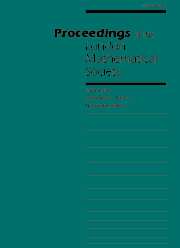Article contents
On Bertini's theorem in characteristic ${p}$ for families of canonical curves in ${\Bbb P}^{(p-3)/2}$
Published online by Cambridge University Press: 08 September 2004
Abstract
Bertini's theorem on variable singular points may fail in characteristic $p$; there are algebraic fibrations that are pathological in the sense that all fibres are non-smooth though the total space admits only a finite number of singular points. We prove that if an algebraic fibration by plane projective quartic curves in characteristic 7 is pathological then, after an eventual cyclic base extension of degree 3, it is, up to birational equivalence, obtained by a base extension from the pencil of quartic curves cut out by the equations $ zx^3 + xy^3 + t yz^3 = 0$.
More generally, we classify pathological fibrations by canonical curves of arithmetic genus $g = \frac{p - 1}{2}$ in the projective space of dimension $\frac{p - 3}{2}$. We prove that the gap sequences of the smooth Weierstrass points of the fibres have the property that a positive integer $\ell$ is a gap if and only if $2g + 1 - \ell$ is a non-gap. In analogy to the Kodaira–Néron classification of special fibres of minimal fibrations by elliptic curves, we construct minimal proper regular models of pathological fibrations, determine the structure of the bad fibres, and study the global geometry of the total spaces.
Information
- Type
- Research Article
- Information
- Proceedings of the London Mathematical Society , Volume 89 , Issue 2 , September 2004 , pp. 291 - 316
- Copyright
- 2004 London Mathematical Society
- 5
- Cited by

